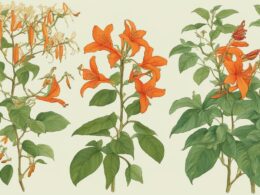When you stop to admire the beauty of trumpet vine flowers, you may wonder how they are able to thrive in their environment. These incredible flowers have a range of unique traits and adaptations that enable them to survive and grow in various conditions.
In this section, we will explore the different adaptations of trumpet vine flowers and how they have evolved over time to overcome challenges such as competition for pollination and adapting to different climatic conditions. By understanding these adaptations, you will gain a deeper appreciation for the beauty and resilience of trumpet vine flowers.
Key Takeaways
- Trumpet vine flowers have a range of unique adaptations that enable them to thrive in diverse environments.
- Understanding these adaptations highlights their versatility as plants and enhances our appreciation for their beauty and resilience.
Trumpet Vine Flower Characteristics: Understanding Their Features
Trumpet vine flowers are renowned for their unique characteristics. These striking flowers boast vibrant colors that range from scarlet red to yellow and orange hues. Their trumpet-like shape is a defining feature, and the arrangement of their petals is equally mesmerizing.
Their petals are fused together to form a long, narrow tube that flares out at the end, creating a trumpet shape. These flowers are typically 2-3 inches in length, making them a standout feature in any garden or natural setting.
Another interesting feature of trumpet vine flowers is their ability to bloom throughout the summer and fall seasons. This extended blooming period is made possible by the production of new flower buds throughout the growing season, ensuring that these plants can adapt to changing environmental conditions.
Trumpet Vine Flower Colors
The color of trumpet vine flowers is one of their most distinctive features. These plants can produce flowers in various shades, including bright red, orange, yellow, and even pink. The color of the flowers can vary depending on the age of the bloom and the amount of sunlight they receive. For example, flowers that receive direct sunlight tend to have a deeper, more intense color, while those that receive less sunlight may be lighter or more muted in color.
Trumpet Vine Flower Shape
The trumpet-like shape of these flowers is a defining feature that sets them apart from other plants. The long, narrow tube of the flower is designed to attract specific pollinators, such as hummingbirds or certain species of bees with long tongues. As these pollinators feed on the nectar inside the flower, they inadvertently transfer pollen from one plant to another, allowing for successful fertilization and seed production. This is one of the key adaptations of trumpet vine flowers that enables them to thrive in their environment.
If you’re looking to add a unique and striking plant to your garden or landscape, consider the trumpet vine flower. Their vibrant colors, distinctive shape, and extended blooming period are sure to make them a standout feature in any setting.
Adaptations for Survival: How Trumpet Vine Flowers Overcome Challenges
Trumpet vine flowers have developed a range of adaptations to overcome various challenges in their environment. These adaptations include their physical characteristics, survival strategies, and evolution.
One of the primary challenges that trumpet vine flowers face is competition for pollination. To overcome this, they have evolved to produce a large amount of nectar to attract pollinators such as hummingbirds, bees, and butterflies. The shape of the flowers also plays a role in this process, as the trumpet-like shape allows for easy access to the nectar.
Another challenge is protection from predators. Trumpet vine flowers have adapted by developing a bitter taste, which deters animals from eating them. They have also evolved to grow high off the ground, making them harder to access for many animals.
Trumpet vine flowers have also adapted to different climatic conditions. In hot and dry climates, they can store water in their stems, allowing them to survive during periods of drought. In colder climates, they have the ability to drop their leaves and go dormant during the winter months, conserving their energy until conditions become more favorable.
These adaptations have not developed overnight, but through the process of natural selection. The plants that were better adapted to their environment were more likely to survive and pass on their genes to the next generation. Over time, these adaptations became more widespread in the trumpet vine population.
Overall, the adaptations of trumpet vine flowers have allowed them to thrive in a wide range of environments, making them an impressive example of the resilience of plant life.
Are the Factors that Make Trumpet Vine Flowers Attractive to Predators Also Causing Damage to the Flowers?
The causes & solutions for trumpet vine flowers being attractive to predators are multifaceted. While their vibrant colors and fragrant scent make them visually and olfactorily appealing to pollinators, these very factors may also attract predators such as insects and birds. The damage caused can range from nibbled petals to complete destruction. To mitigate this, creating a diversion by planting companion plants or using physical deterrents can protect the trumpet vine flowers without impacting their natural appeal.
Environmental Adaptations: Thriving in Various Habitats
Trumpet vine flowers are known for their ability to thrive in different environmental conditions. Their adaptability is due to several unique adaptations, which allow them to survive in various habitats.
| Adaptation | Description |
|---|---|
| Root System | The roots of trumpet vine flowers grow deep into the soil, allowing them to absorb nutrients and water from deeper layers. This adaptation enables them to resist drought conditions and thrive in dry soils. |
| Leaf Structure | The leaves of trumpet vine flowers are thin and delicate, with a large surface area that allows them to absorb more sunlight. The leaves are also arranged in a way that minimizes water loss through transpiration, enabling them to survive in hot and dry conditions. |
| Versatile Pollination | Trumpet vine flowers are pollinated by a variety of insects, including bees, hummingbirds, and butterflies. This adaptation allows them to thrive in different environments, as they do not rely on a specific pollinator species. |
The ability of trumpet vine flowers to grow in various habitats makes them a valuable plant for landscaping. They can be used to enhance the aesthetic appeal of gardens, fences, and walls. Additionally, their adaptability makes them a popular choice for urban settings, where they can grow in challenging conditions.
In conclusion, trumpet vine flowers have several environmental adaptations that enable them to thrive in different habitats. Their root system, leaf structure, and versatile pollination strategies make them well-suited for a range of environmental conditions. By understanding these adaptations, you can appreciate the versatility and resilience of trumpet vine flowers.
Conclusion
Now that you have learned about the unique adaptations of trumpet vine flowers, you can appreciate their beauty and resilience even more. Their physical features, survival strategies, and environmental adaptations make them well-suited for their habitats and able to thrive in diverse environments.
By understanding the adaptations of trumpet vine flowers, you can also gain insights into how other plants have adapted and evolved to survive in their environments. It is fascinating to see how nature has such a remarkable ability to adapt and thrive, even in the face of challenges.
Keep Exploring Nature’s Fascinating Adaptations
Now that you have learned about trumpet vine flowers, why not keep exploring the fascinating adaptations of other plants and animals in nature? There is so much to discover and appreciate in the natural world, and every living thing has its own unique story to tell.
FAQ
Q: How are trumpet vine flowers adapted?
A: Trumpet vine flowers have several adaptations that enable them to survive and thrive in their environment. Some of these adaptations include their vibrant colors, trumpet-like shape, and the arrangement of their petals. These traits attract pollinators, such as hummingbirds, who play a crucial role in the plant’s reproduction.
Q: What are the characteristics of trumpet vine flowers?
A: Trumpet vine flowers have vibrant colors, ranging from orange to red, that attract pollinators. They have a unique trumpet-like shape, with a long tubular corolla and a wide mouth. The arrangement of their petals is often fused at the base, forming a distinctive cup shape.
Q: How do trumpet vine flowers overcome challenges for survival?
A: Trumpet vine flowers have evolved several survival strategies to overcome challenges. They produce abundant nectar to attract pollinators and increase their chances of successful reproduction. They also have small hairs on their leaves and stems, which provide protection against herbivores. Additionally, their ability to tolerate a wide range of climatic conditions allows them to adapt to different environments.
Q: What environmental adaptations do trumpet vine flowers have?
A: Trumpet vine flowers have various environmental adaptations that allow them to thrive in different habitats. They can tolerate a wide range of soil types and are often found in disturbed areas. They are also well-adapted to growing in full sun or partial shade, making them versatile in various light conditions.









